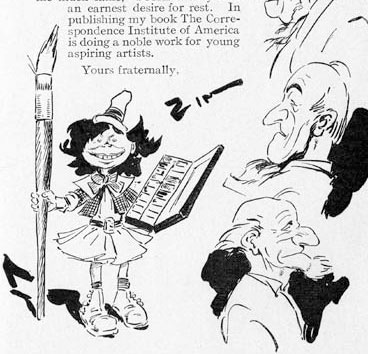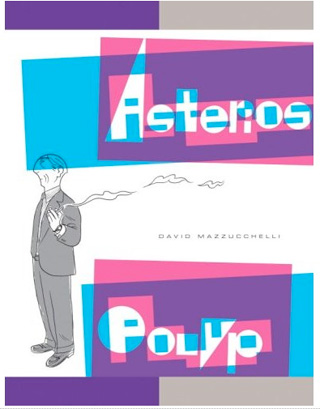I like this Flickr set of album covers reimagined as Pelican paperbacks:

Also, I have an invented a test. First, view this image. Now check under the fold for the answer.
Was your first reaction: shouldn’t that be ‘dwarves’? If so, you are way too influenced by J.R.R. Tolkien.
Next: ASIFA is serializing – for a limited time only! – an e-book version of Eugene “Zim” Zimmerman’s Cartoons & Caricatures, or Making The World Laugh (1910), in 5 page installments. I’ve downloaded my first five. I love this stuff.
Zim was the founder of the so-called “Grotesque” school of caricature, and was the first caricaturist to incorporate exaggerated cartooniness not only in the faces of his subjects, but in the bodies as well. Zim worked for Puck and Judge, the two top humor magazines of their day. Along with caricatures by George McManus and Frederick Burr Opper, Zim’s caricature of a moon faced grinning kid (an example of which appears on page 3 of this book) was said to be one of the earliest inspirations for Mad magazine’s mascot character, Alfred E. Neuman

Last but not least, Scott K. points out that you can read eight pages from David Mazzuchelli’s Asterios Polyp [amazon]. I just finished and I really, really, really liked it. The whole book, I mean. The eight pages are nice, too.

{ 25 comments }
Eszter Hargittai 08.23.09 at 2:05 pm
shouldn’t that be ‘dwarves’?
Nope. My first reaction was what’s in the comments on the Flickr page: weird title. And even the clarification about the first sentence in the book didn’t make me think: “oh, okay, I get it now” although I guess it helped a little.:-}
I like the plane one you picked and these two as well:
http://www.flickr.com/photos/littlepixel/3380898542/in/set-72157594269138651/
http://www.flickr.com/photos/littlepixel/3546918396/in/set-72157594269138651/
Anthony 08.23.09 at 3:17 pm
My first reaction was “what does the girl on the cover have to do with dwarfs?”
MR Bill 08.23.09 at 8:01 pm
Same here, Anthony.
I guess I’m only aware of Penguin’s Classics line. Are all their new paperbacks sooo..
bland?
kid bitzer 08.23.09 at 10:57 pm
“first caricaturist to incorporate exaggerated cartooniness not only in the faces of his subjects, but in the bodies as well.”
must be some implicit restrictions on quantification going on here, else it’s clearly false, e.g. da vinci, medieval gargoyle carvers, etc. etc.
Jacob T. Levy 08.23.09 at 11:20 pm
“Was your first reaction: shouldn’t that be ‘dwarves’? ”
Yes. But my second reaction was to immediately recognize that that’s what the test would be, and that I had walked right into your trap. :-)
John Holbo 08.24.09 at 12:23 am
Aw, I knew you’d fall for it, Jacob.
Re: “must be some implicit restrictions on quantification going on here, else it’s clearly false, e.g. da vinci, medieval gargoyle carvers, etc. etc.” Yes, this is true, but I think it’s also true that the style in these cartoons is fairly new. It’s a bit hard to pin that down. It’s not just exaggerated body parts, although that’s a necessary component. I am genuinely getting interested in the origins of modern cartooning styles. So I’d be curious if anyone has any bright ideas.
rand careaga 08.24.09 at 3:07 am
The album covers are marvelously done (inspired by Criterion’s cover treatment for its recent release of Wise Blood, I wonder?), but would have had more resonance for me if I recognized more than a tenth of the albums–hell, of the recording artists–reimagined. We become exiles in the culture as we age, I suppose.
John Quiggin 08.24.09 at 5:33 am
It was about my third reaction, I have to admit, and I kind of guessed it had to be the test.
mollymooly 08.24.09 at 5:48 am
@rand careaga
You must be quite old; those albums seem to span the last 30 years quite evenly. A bias towards UK and/or electronica might have hurt you more.
James Wimberley 08.24.09 at 10:08 am
James Gillray made a trademark of highly distorted figures for political caricature in the eighteenth century.
Ginger Yellow 08.24.09 at 12:45 pm
Yeah, I was going to bring up Gillray myself.
“I am genuinely getting interested in the origins of modern cartooning styles. So I’d be curious if anyone has any bright ideas.”
The endpages of Spiegelman’s In The Shadow Of No Towers have a short history of the origins of newspaper comic strips. It’s mainly interested in how the characters developed and were received, but you can learn a lot abut the visual styles as well. Also, you can find collections of Herriman’s hugely influential Krazy Kat easily enough and they’re a fantastic read.
rand careaga 08.24.09 at 2:07 pm
@mollymooly
You must be quite old. Geez, that’s a hell of a way to start a Monday. I gradually stopped paying attention to popular music as an undergraduate in the first few years of the 1970s because I thought it was becoming turgid and overproduced. A chance exposure to early Talking Heads impressed me with their (initially) stripped-down sound, and I looked in again in a dilettantish fashion for a few years after that. Now it’s just too damned much of an ordeal to struggle into the walker, hobble across the parlor and fire up the Victrola (and besides, Lali Puna won’t release their stuff on 78s).
Russell Arben Fox 08.24.09 at 2:16 pm
I didn’t notice the spelling. I was too busy thinking about why the prospect of a tall, leggy, scantily-clad exotic dancer/porn star might be relevant to the dubious interests of short men.
Oh give me a break, it’s Monday.
kid bitzer 08.24.09 at 3:07 pm
daumier’s louis/poire dates from the early 1830s; later than gillray, but still a fair sight earlier than zimmerman.
Anderson 08.24.09 at 3:43 pm
Tolkien himself clearly distinguished between short people (dwarfs) and members of the dwarven race (dwarves).
ajay 08.24.09 at 4:08 pm
I think if your answer is along the lines of 15, then you are definitely way too influenced by Tolkien.
Matt 08.24.09 at 4:14 pm
No one has pointed out that it should be “Licensed to Ill”.
Also, I didn’t notice the spelling, probably because the last DVD I watched was “Even Dwarfs Started Small” by Werner Herzog. “A Good Year For Dwarfs” sounds like a great sequel title.
rob 08.24.09 at 9:31 pm
“The real historical plural of ‘dwarf’ (like teeth of tooth) is dwarrows anyway: rather a nice word, but a bit too archaic. Still I rather wish I had used the word dwarrow.”
Reference: The Letters of JRR Tolkien Letter # 17 To Stanley Unwin, Chairman of Allen and Unwin, p. 23, 24
John Holbo 08.25.09 at 6:20 am
“No one has pointed out that it should be “Licensed to Illâ€.”
My god, you’re right.
roac 08.25.09 at 6:41 pm
Curse you, Rob at 18! I was so looking forward to trotting out “dwarrows.” At least I can provide one bit of additional information, namely that the paradigm for dweorh -> *dwarrows is burh -> barrows.
Ajay would obviously classify you and me as way, way too influenced by Tolkien.
If there is evidence for the statement at 15, I am not aware of it. “Dwarves” was a mistake, as Tolkien admitted.
kid bitzer 08.25.09 at 6:45 pm
@ 20–
dwarf to dwarrows?
so, wait: the singular of wheelbarrows should be “wheelbarf”?
roac 08.25.09 at 7:53 pm
Oooh goodie, someone took the bait! No, the barrow in “wheelbarrow” is a different word from “barrow” a grave-mound. It is from Middle English “bearwe.” The OED thinks that “bearwe” must be from an Old English word derived from beran “carry.” (No such OE word is to be found in the surviving literature. Linguists however have no compunction about presuming that it existed; they just signal its disappearance with an asterisk.)
There are actually four noun entries for “barrow” in OED. One means a castrated boar and one is a kind of coat. Etymologically, they’re four different words that just happen to be spelled and pronounced the same.
roac 08.25.09 at 8:10 pm
Oops, correction to 20: The OE word that became “barrow” was beorh not burh, which is a different word though related. Should have looked it up instead of relying on memory.
The history is that beorh meaning “hill” survived and turned into “barrow” only in the SW of England, where it was used in the names of hills, such as “Long Barrow.” 19th-century archaeologists adopted the dialect word as technical term for a type of grave-mound. Hence Tolkien’s “Barrow-downs” and Barrow-wights” (a term he borrowed from Andrew Lang).
kid bitzer 08.25.09 at 8:20 pm
that makes all the difference then. “wheelbarrows” are not even under consideration.
rather, it is the singular of “long barrows” that should go to “long barf”.
thanks for clearing that up.
roac 08.25.09 at 8:22 pm
My pleasure.
Comments on this entry are closed.